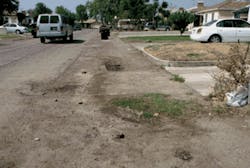Stormwater Project Transforms Flooding into Valuable Resource
by Martin Spongberg
A comprehensive stormwater demonstration project is under way in a Los Angeles, CA, neighborhood that seeks to mitigate chronic flooding problems through infiltration of captured stormwater. In addition to reducing runoff, the project is designed to augment groundwater supply, reduce residential water usage, and enhance the area's aesthetics and habitat utilizing a sustainable landscape of native and drought-tolerant plants.
The project site is a 24-home neighborhood on Elmer Avenue in the flood-prone community of Sun Valley. The neighborhood was developed beginning in the 1940s and, like all of Sun Valley, has no storm sewers. Storm runoff flows into the 5-acre neighborhood from a 37-acre neighborhood to the north, contributing to street flooding that typically occurs during even moderate storms.
The Elmer Avenue Neighborhood Demonstration Project is managed by the Los Angeles & San Gabriel Rivers Watershed Council (Watershed Council) with multiple partners and agencies, including the City of Los Angeles. The earth science and engineering firm AMEC Geomatrix, Inc. provided planning and design work with landscape architecture assistance from Dudek & Associates and WelDesign. The project is part of the Los Angeles Basin Water Augmentation Study, which is led by the Watershed Council in partnership with eight local, state, and federal agencies. The study objective is to assess the practical potential for improving surface water quality and increasing local groundwater supplies through infiltration of urban stormwater runoff.
“The Elmer Avenue BMPs will likely be able to capture and infiltrate all runoff from a 2-year storm, which is 2.6 inches in a 24-hour period,” said project manager Martin Spongberg, PhD, a senior engineer with AMEC. He noted that many elements of the project were specifically designed to take full advantage of the soil profile for the area — gravelly sand and sandy gravel — which has extremely high potential for infiltration.
“The design components of this project should be replicable in many parts of Southern California and in other parts of the country,” added Dr. Spongberg.
One unusual aspect of the project is that it involves both the public right-of-way and homeowners' private property. As such, the support and involvement of the neighborhood's predominantly Spanish-speaking residents was essential. With the assistance of the homeowners, data on site vegetation, soils, irrigation practices, water use, and aesthetic preferences was gathered.
Homeowners contributed to the design process, too, providing input and recommendations at five community meetings on this sustainable, low-impact redevelopment project. The workshops, held in the county library, a nearby park, and right on site, were conducted in Spanish with English translation. Workshops were organized by the Watershed Council, working with TreePeople, Urban Semillas, AMEC, Dudek, and WelDesign.
As a result of the community-outreach efforts, which included the drafting of plans in Spanish and English, and because the neighborhood had been very vocal about its flooding woes and the dilapidated condition of its street, residents were very willing participants in planning the project and supportive of its sustainable features, said Edward Belden, the Watershed Council's Water Programs Manager.
The homeowners selected a palette of native and drought-tolerant plants and trees to replace existing lawns. After establishment, the selected plants will require little or no water, other than that supplied by nature. Strategies they supported to capture runoff from private property included rain gardens, gutters to direct rooftop runoff toward rain barrels, and vegetated swales running the length of Elmer Avenue on both sides of the street. It was also agreed that driveway drains and curb inlets would be installed to direct runoff to the vegetated swales for natural infiltration.
Runoff from the 37-acre neighborhood to the north will be captured through catch basins discharging to a subsurface infiltration gallery. The gallery will consist of two 18-inch-diameter perforated pipes in a gravel bed installed underneath Elmer Avenue. The gravel bed and pipes will run the length of the 600-foot long Elmer Avenue in order to spread out distribution of the water for maximum infiltration. To minimize project costs, construction of the infiltration gallery is being coordinated to coincide with street work planned by the City of Los Angeles.
“Because of local geologic conditions, we anticipate unusually high infiltration rates. The design rate is 150 gallons per day through each square foot of the bottom of the gravel bed,” said Dr. Spongberg.
The expected infiltration rate is conservatively based on multi-day percolation studies conducted by the Los Angeles County Department of Public Works at nearby Sun Valley Park and at the local middle school, as well as percolation tests performed by AMEC from boreholes installed at both ends of Elmer Avenue.
The quality of the water will be tested before it reaches the infiltration gallery and during percolation. Two lysimeters will be installed about 30 to 40 feet below ground surface for testing during percolation. The groundwater table is more than 250 feet below ground surface. It is anticipated that by the time the water filters through the sandy soil and coarse sediment it will be of higher quality than the groundwater it recharges.
This prediction is based on similar studies AMEC has performed at other Watershed Council infiltration study sites. During four monitoring seasons, stormwater, lysimeter, and groundwater samples were collected from six sites with installed stormwater infiltration BMPs. The monitoring demonstrated that captured stormwater can be utilized to augment groundwater quantity and, in many cases, actually improve groundwater quality.
Through the Elmer Avenue project, stormwater runoff will be transformed from a nuisance that pollutes streams and the ocean to a valuable resource that can supplement precious water supplies. Construction of this project is underway with completion expected in Summer 2009.
About the Author:
Dr. Martin Spongberg is a senior engineer with AMEC Geomatrix and has more than 25 years of professional experience, primarily in the fields of geophysics, stormwater engineering, hydrology, and hydrogeology. He currently is working on several projects designing, implementing, and monitoring stormwater BMPs.



